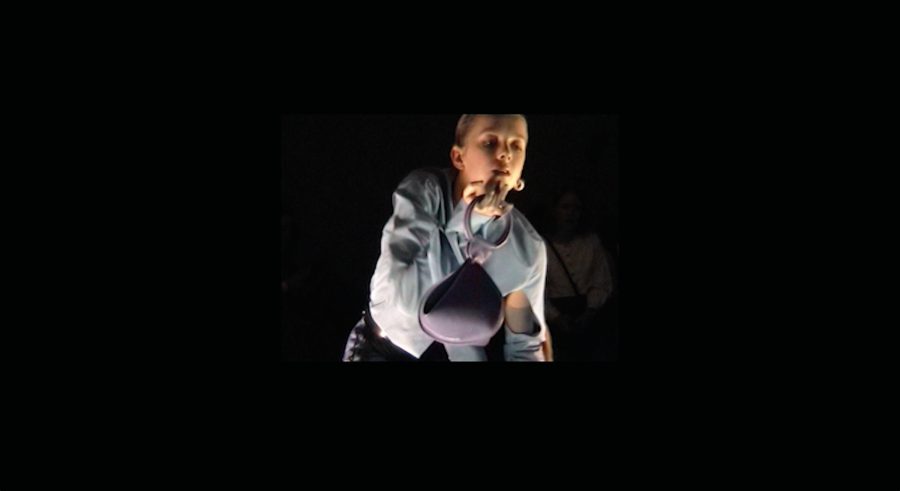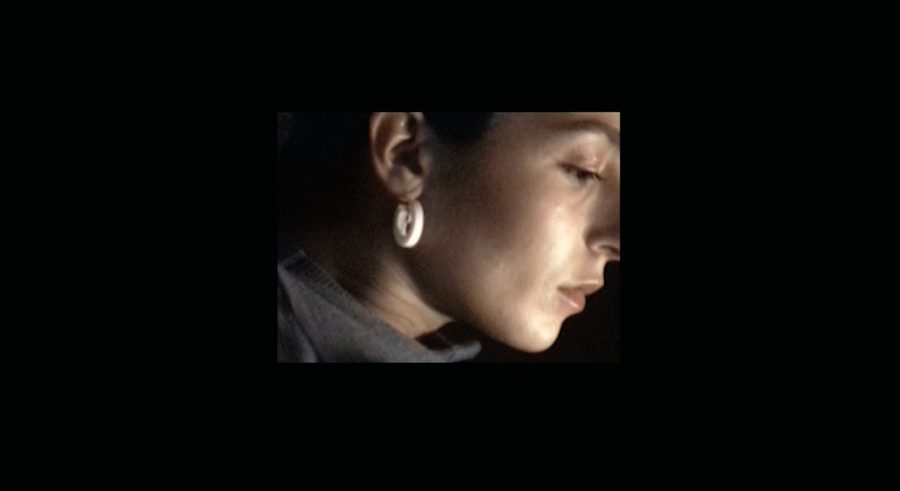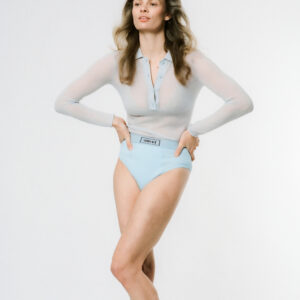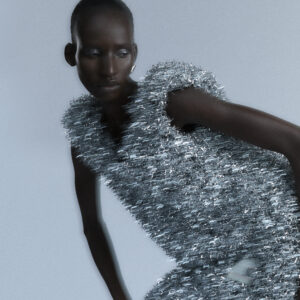Emma Charles / Northern Power House
Feature 09.05.18
Videography + Art Direction Katia Cardoso Words Katia Cardoso + Simone Konu Rae Creative Direction, Production + Styling Emma Charles
The softly spoken Emma Charles is not afraid of making a statement. Graduating in 2014 from the University of Westminster, stints at Tom Ford, Stella McCartney and Preen have shaped this young designer. Despite working for some fashion Goliaths, Emma has taken her own unique approach to building a fashion collection, starting small and keeping it personal. Also met Emma to discuss her recent collection and what inspires her.
You have a lot of experience working at great design houses, at what point did you realise you wanted to set up your own label?
I was toying with doing a Masters for a long time. And I went to open days and was really thinking yeah I’m going to do a Masters. And obviously it’s so much money. I had this crazy thought, why not invest the money that I would be spending on a Masters, in making a small collection and try to get it out there. And so that’s what I did. It was really small, just 9 looks, and slowly it got bigger from there. So the first collection went to Paris for a sale room, and I got an order and I was like woo! The next collection I made was 12 looks and then it was 15, and now it’s 18 looks, so we are growing slowly and adding more each season. We have developed from the showroom to a presentation, hopefully one day there will be a runway show. Thats’s the goal.

Do you come from a creative background?
I have a really creative family. One of my Aunties used to be a print designer. Another owns her own restaurant. I’ve got an Uncle who’s a fine artist, and another Auntie who is a florist. But then my dad works in the oil industry and my Mum is a dinner lady at my old school.
So you come from a family of strong working women!
Yeah, my Dad is one of seven, and five of them are women on that side. They are all really strong, and it’s good to be like that. My mum is one of five sisters and they’re all very family oriented, they all have at least three kids, so they are strong in a different kind of way. I have a lot of amazing women around me.
How do you think that influences your label?
So every bag is named after one of the strong women in my life; the Lady Margaret which is my Mum, the Lady Bren which is my Nana, the Lady Vera, who’s my other Nana, the Lady Caroline and Lady Rose are both my Aunties. And then there is my Sister’s new little baby, called Agnes, so my most recent bag is The Agnes. Rather than just being quite boring names, it’s personal and they are like proper Ladies. It gives them a bit of status.

Where did you grow up?
Near Middlesbrough, Teeside. The whole area is built up around the steel industry, because they used to mine for the iron ore from the hills and extract it from the rock. In 2015 the blast furnace closed down. It looks like a big shadow in the distance, and lots of people who are from there think that it’s an eyesore and that it’s really ugly. I always thought it was beautiful. I had the opportunity to make a film there, to showcase my Spring Summer 18 collection. My goal was to make people see the beauty in it.
Has this inspired your design process?
Yes. That process of something being created, they produce steel there, it’s such an industrial system. And it seems that most people’s Dads worked in the steel industry, or in ‘the works’ as we like to call them. My Dad started there as an intern, a trainee in the energy plant, and then went offshore because that’s the training people had around there. Just being there, the presence of it is quite creative.
But then we’ve got the countryside and the seaside too. I find the whole area beautiful. I appreciate it more having moved away. At the time obviously I appreciated it but it was all I knew. It was just the norm to live right beside a blast furnace.

How would you describe the Emma Charles woman?
She is strong, confident, knows her mind and knows what she likes and what she doesn’t.
She’s mid twenties to mid thirties, and then if she’s a bit more creative she’ll carry on buying pieces into her forties and beyond. The tailoring can be worn by a range of women. There are pieces you could wear to work but then it’s still quite fun, it’s not really serious tailoring; it’s got piping on a sleeve, funky colours – like the two toned suit; it’s playful. She’s modern and she’s fashion considerate rather than fashion conscious.
Are you influenced by menswear?
I really love men’s tailoring especially from the twenties, and that strong masculine shape. I like classic menswear fabrics, so there’s been collections where I’ve made a really feminine shaped dresses but in a tailoring wool, just to make it a bit tougher. I always like to find that balance, because I’m not super girly but I’m still quite feminine, and I want my clothes to be feminine but not really pretty. I think that having a reference to menswear balances the collections. Women don’t always want to wear frou-frou dresses. They want to have that staple trouser in their wardrobe, or that jacket that they keep going back to.
What was the main inspiration for your latest collection?
I looked back at the twenties again, as there’s so much to take from that era. I had a vase that I’d found in an antique shop, it was shaped like a shell and I was trying to work out how I could do my embroidery so that it isn’t super girly, so I translated the shell shape into the embroidery. I looked again at the dropped hem lines, dropped waist and the flappers but mixed it with tailoring to create something modern.
How do you decide on the fabrics for the collection?
I make sure that I keep tailoring wools in there, so I go to mills that are known for having good tailoring wools and then I’ll go to their showroom, go through their hangers, see what’s available. The fabric informs you first and foremost. I think if you find a beautiful fabric you really want to use it. I’m like ‘oh my god that fabric is amazing’ and then I’ll be like ‘oh what can I make in it’. It then whirls on from there rather than doing a sketch and searching for a fabric which will suit that sketch. The fabric comes first.

What inspired you to showcase your collection as a contemporary dance performance?
It goes back to the twenties when modern dance was revolutionised by key women like Martha Graham, an American dancer who changed the whole notion of modern dance; it was all very prim and proper before her. She revolutionised the whole movement to what it is today. A really good friend of mine, Andrew Weiss, is a choreographer, and ever since I first saw his work I’ve been in awe. You get goose bumps when you watch the dancers. Hopefully my presentation gave people a breathtaking moment. And the dancers were really close in amongst the crowd, it’s really intimate. I always want the work to be seen, and for people to be able to experience it.
How do you try and keep your label authentic and personal as well as finding that balance of keeping it commercial?
The brand, the designer, is me, so it needs to be influenced by things that I love, places that I love. With luxury fashion I think people buy into the designer and they’re buying into that whole mystery of ‘what’s the designer like? what are your interests?’ I want it to be personal to me because it’s my everything. I’ve put everything into it, so why should I say ‘oh lets just do a black dress because it will sell’. It needs to represent my personality. I think with each collection people are getting a strong sense of the Emma Charles woman, but it’s a bit different each season. You can see there is an evolution.
How do you stay unique compared to other designers?
I think that’s just staying true to yourself, and staying true to what you like rather than being too bothered about what the people around you are doing. Obviously I look to see what so and so is doing. But each new designer has got their own thing. I’d like to think people see that I have balance between femininity and tailoring, and rather than it being too similar every season, that it’s still evident in my work. Keeping true to what you love is what makes a designer unique, it connects us because we’re all doing what we love but also makes us stand out for different reasons, which is a good thing.

How much do you consider sustainability and ethical production?
The starting point is knowing exactly where you’re getting the garments produced and where the fabrics come from. I think that’s the most important way, being able to to track and point to where your garments are made. For instance I know that a man called Alberto in Milan made my bags, handcrafted my bags, I know the person, I know where he is. I think that’s the first step to being sustainable. It’s important that people are aware that I’m not just sending something to say one factory and they’re outsourcing it somewhere else. If that happens then I have no clue where it’s being made and I don’t know the working conditions or know where the fabrics actually come from. Using suppliers that have a clean supply chain is crucial. If you ask them where did this come from, they should be able to tell you which mill in Italy, or even if it comes from a mill in China at least they know. I think that you just have to be aware. And I think for a new designer it’s easier to start with this kind of trail from the beginning and make sure that you’re conscious of the factories that you’re using and their working conditions.
You clearly have a lot going on. How do you keep up with everything?
Oh I don’t know, sometimes I think the adrenaline just keeps you going. So I’ll start the pattern cutting, the process of making the clothes and I have that in one part of my brain, and then creating the show is in another part, and then sales is in another. I’m amazed at how it is all in here, but it seems to be working! Time management, critical paths and spreadsheets, remembering that ‘I need to do this today or if I don’t do it today it’s going to have a knock on effect’. You have to be good at time management. I’m totally absorbed in every element of it because I want it to be successful.
If you’re a creative person, it’s not what you do it’s who you are. I’m a designer, it’s who I am, it’s not ‘oh I just decided to be a designer’, it’s in me. I felt embarrassed to want that, but then having gained more experience in the industry I realised that’s what I want to be. I’ve come this far, I am a designer. I’m going to make my own clothes and have my name out there. You have to adapt and learn all these other skills to be able to be creative and make the things that you want to make happen.


